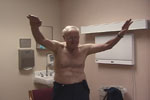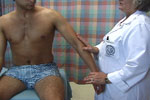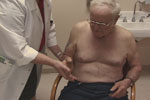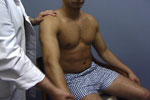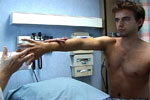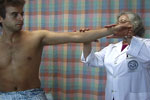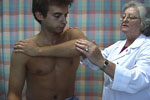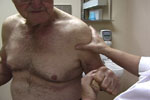Key Elements of the Shoulder Examination
-
Covered in Part One:
- Observation of Spontaneous Function and Limitations
- Inspection
- Range of Motion Testing
- Palpation of Anatomical Structures
-
Covered in Part Two:
- Special Test Maneuvers to Demonstrate Shoulder Disorders
-
Covered in Part Three:
- Muscle Strength Testing
- Referred Pain to the Shoulder
-
Radiographic Testing
- X-rays of the shoulder
- MRI
- Ultrasound
Special Tests for the Shoulder Exam
Special test maneuvers are an important component of the systematic physical examination of the shoulder region. They help confirm or reject diagnostic considerations developed during the medical interview and basic physical examination. These test maneuvers are based on the underlying structural and functional anatomy of the region and are designed to demonstrate the pathologic cause of shoulder pain and dysfunction. The arm is placed in various positions and the patient is instructed to move against resistance applied by the examiner. This will isolate the action of individual muscles and/or put stretch or pressure on the sites of pathology. Unfortunately no 'one test' is sufficiently sensitive or specific to be diagnostic in and of itself.
The combination of history, symptom pattern, and basic physical exam findings, together with one or more abnormal special tests, will indicate the most likely diagnosis to use for selecting treatments. Some tests carry the eponym of the physician who described the test. The clinical utility of the test may not have been independently tested before use became generalized. The evidence, if available, for clinical performance of a special test will be reviewed and sources of false positive and false negative results will be described.
If arm weakness, muscle atrophy or fasciculations are evident during the shoulder examination, systematic sensory and muscle strength testing should be carried out to localize the deficit. Consideration must always be given to the possibility that pathology outside the shoulder region is producing pain referred to the shoulder (to be covered in Part Three).
Painful Arc of Motion Test
The Painful Arc of Motion Test is a simple clinical test to identify which segment of active forward flexion or abduction reproduces the patient's pain.
-
The patient is instructed to elevate the arm in the Scapular plane (60° lateral to forward flexion) as far as possible.
- The patient is instructed to abduct the the arm as much as possible. Pain occurs between 60° and 120° with impingement.
Tests for Rotator Cuff Tendon Problems
Both Rotator Cuff
(anterior,
posterior) tendonitis and tears produce signs of impingement. Several physical testing maneuvers can focus stress on the individual muscle tendons of the Rotator Cuff and reproduce the patient's pain.
-
-
The Supraspinatus Tendon can be stressed by moving the extended arm into 90° of abduction and 30° of forward flexion. This positions the arm out along the angle of the Scapular Spine to get maximum contraction of the
Supraspinatus muscle. The humeral head is internally rotated in the thumb down, 'empty can' position. The patient is instructed to 'push up' against resistance, with the palm parallel to the floor to stress the Deltoid Tendon insertion and with the thumb down to stress the Supraspinatus Tendon insertion.
- Resisted Abduction of the arm held out at 30° to 45° produces lateral arm pain in patients with Supraspinatus Tendonitis.
-
Tendonitis of
Infrapsinatus and/or
Teres Minor muscles produces posterior shoulder pain with external rotation. The patient's arm is flexed to 90°. The examiner supports the elbow with one hand next to the torso. The examiner grasps the forearm and instructs the patient to resist the examiner's attempt to externally rotate the arm, thereby testing Resisted External Rotation.
-
- Tendonitis of the Subscapularis muscle produces antero-medial shoulder pain. The patient's arm is flexed to 90°. The examiner supports the elbow with one hand next to the torso. The examiner grasps the forearm and instructs the patient to resist the examiner's attempt to internally rotate the arm, thereby testing Resisted Internal Rotation.
- The Lift-off Test: The arm is internally rotated by having the patient place the dorsum of the hand on to his or her lower back. The patient is instructed to lift the hand off the back against slight resistance. If the patient feels weakness and/or pain, this indicates a subscapularis lesion with 80% sensitivity and 100% specificity.
Adhesive Capsulitis ('Frozen Shoulder')
Limited passive and active range of motion in all directions is found with adhesive capsulitis or 'frozen shoulder'.
Rotator Cuff Impingement Signs/Tests
A variety of testing maneuvers have been described to demonstrate Rotator Cuff tendonitis. There are a variety of causes of this condition, including abnormal acromial morphology, osteophytes at the A-C joint, calcium deposit in a Rotator Cuff tendon, and gleno-humeral hyperlaxity with a high riding humeral head. All of these abnormalities can be identified by x-ray, ultrasound, and/or MRI.
-
Pain on Forced Forward Flexion (Neer's Impingement Sign): The examiner fixes the Scapula with one hand and passively elevates the patient's arm forward, up overhead with the other hand. This motion impinges the anterior edge of the
Supraspinatus Tendon between the Greater Tuberosity of the Humerus and the
Coracoacromial Arch. This maneuver produces pain with impingement, but also with
acromioclavicular arthritis and adhesive capsulitis. The injection of 10cc 1% xylocaine into the subacromial space relieves the pain caused by impingement and is termed the Neer Impingement Test.
-
Pain with Forced Internal Rotation of the Extended Arm (Hawkins Impingement Sign) : The arm is positioned at 90° of forward flexion. Forcible internal rotation abrades or impales the Supraspinatus Tendon against the
Coracoacromial Ligament and reproduces the pain of impingement.
-
Posterior Impingement Sign: The arm is placed at 90° of abduction and maximum external rotation. This produces deep posterior shoulder pain with impingement of the deep surface of the Supraspinatus Tendon on the Posterior Superior
Glenoid Labrum (seen with overhand throwing injuries).
Evidence Base for Clinical Utility: These tests do not distinguish between Tendonitis and Rotator Cuff Tears unless weakness is present (see below). Thus far there is no conclusive evidence that any single special test can conclusively diagnose rotator cuff disorders. In a systematic review of ten published studies, the accuracy of clinical examination tests in shoulder disorders indicated an overall sensitivity of 90% and specificity of 54% to detect full thickness rotator cuff tears. In contrast, sensitivty and specificity for MRI was 89% and 93% respectively. Ultrasonography has 87% sensitivity and 96% specificity.
[JDinnes et al. "The Effectiveness of Diagnostic Tests for the Assessment of Shoulder Pain Due to Soft Tissue Disorders: A Systematic Review." Health Technology Assessment 2003; Vol 7 No. 29.]
Tests for Rotator Cuff Tears
Partial and complete Rotator Cuff Tears produce pain during the impingement tests described above with variable degrees of weakness and limitation of active range of motion.
-
Drop Arm Test (Codman's Test): The Drop Arm Test depends on weakness due to a complete Rotator Cuff tear greater than ~2.5cm. The examiner passively raises the arm to 90° of abduction and removes support. If the Rotator Cuff tear is large, the arm falls to the side when unsupported. With smaller Rotator Cuff tears the patient can hold the arm in abduction, but slight downward pressure by the examiner produces marked pain and causes the arm to fall. Repeating the Drop Arm Test in various degrees of internal and external rotation of the arm may help localize the lesion as the tear separates more widely over the humeral head.
-
Abrasion Sign:The arm is placed at 90° abduction with 90° elbow flexion and is rotated internally and externally. Crepitus with internal/external rotation indicates the Rotator Cuff tendons are abrading the undersurface of the Acromion and
Coracoacromial Ligament.
-
Lift-Off Test: The patient is instructed to place the dorsum of both hands on the lower back and to lift hands away from the back against slight resistance. Weakness indicates
Subscapularis tear or inflammation.
Evidence Base for Clinical Utility: Three simple tests were predictive of Rotator Cuff tears in 400 patients:
- Supraspinatus weakness (abduction)
- Weakness in external rotation
- Impingement in internal rotation, external rotation or both directions
In patients of any age who had all three test abnormalities, and in those age 60 or over who had two of three abnormal tests, there was a 98% chance of having a Rotator Cuff tear. Importantly, if none of these clinical tests were abnormal, there was only a 5% chance of having a Rotator Cuff tear. The predictive value of these combined clinical tests is similar to the diagnostic utility of MRI and ultrasonography. Furthermore, the Drop Arm Test had only 10% sensitivity but was 98% specific for Rotator Cuff tears.
[Murerell GAC & Walton JR. "Diagnosis of Rotator Cuff Tears". The Lancet 2001;357: 769-770.]
Tests for Shoulder Instability Problems
Tests for shoulder instability either evoke recurrence of symptoms or demonstrate degree and direction of laxity. However, signs and symptoms of Rotator Cuff problems may also be produced by shoulder instability.
-
Provocation Tests for Instability
- Apprehension Test for Shoulder Dislocation ('Crank Test'): With the patient supine, the Humeral Head is placed in a position of imminent luxation to reproduce the pain and fearful anticipation. Place the arm in 90° of abduction and externally rotate the arm and/or apply an posterior-anterior force. Anterior shoulder pain and apprehension occurs if there is anterior instability. However, this test may also be positive due to pain from impingement.
- Relocation Test (Fowler's Sign or Jobe's Test): With the patient supine, the arm is abducted to 90° and externally rotated up to 90° to produce posterior-superior shoulder pain and apprehension. These symptoms are relieved by applying an anterior-posterior force to prevent anterior luxation.
- Surprise Test (Anterior Release Test): During the Relocation Test, the examiner suddenly releases the pressure depressing the Humeral Head and the pain and apprehension returns.
- Posterior 'Clunk': A posterior 'clunk' and/or pain while moving the abducted arm into horizontal adduction and internal rotation suggests posterior instability, labral tear, or inferior glenoid exostosis.
-
Laxity Tests (Load and Shift Test or Seated Stability Test)
Laxity Tests evaluate the amount of translation of the Humeral Head on the Glenoid in various directions and are not intended to produce discomfort. The examiner stabilizes the Acromion with one hand and gently moves the Humerus with the other hand. A 'clunk' and feeling of apprehension produced by anterior motion, inferior distraction, and posterior motion indicates anterior, inferior, or posterior instability respectively. A positive response in all directions is called multidirectional instability.
Evidence Base for Clinical Utility: In a study comparing three provocative tests, the Surprise Test was the most accurate diagnostic test for shoulder instability because it had the high Positive Predictive Value and the high Negative Predictive Value.
| Apprehension Test | Relocation Test | Surprise Test |
| Sensitivity | 53% | 46% | 64% |
| Specficity | 99% | 54% | 99% |
| Positive Predictive Value | 98% | 44% | 98% |
| Negative Predictive Value | 73% | 56% | 78% |
[Lo IKY et al "An Evaluation of the Apprehension, Relocation and Surprise Tests for Anterior Shoulder Instability." Am J Sports Med. 2004; 32:301-307. ]
Tests for Labral Tears
Shoulder instability is often accompanied by tears in the
Biceps-Glenoid Labrum anchor. However, instability may occur in the absence of labral tears, and labral tears may occur without shoulder instability. A Bankart lesion is an anteroinferior labral tear usually resulting from anterior dislocation or instability. A SLAP lesion is a Superior Labral Tear from Anterior to Posterior, often from a "FOOSH" injury (fall on outstretched arm).
-
Active Compression Test (O'Brien Test): The extended arm is placed in 90° of forward flexion and 15° adduction, or the hand is moved across the chest and placed on the opposite shoulder. With the hand pronated ('thumb down') the patient is instructed to resist downward force by the examiner. Superficial pain at the top of the shoulder with the thumb down suggests Acromioclavicular Joint pathology. Deep shoulder pain suggests an anterior
Labral tear. For this test to be "positive" for a Labral tear, the induced pain must be relieved when the hand is supinated to the 'thumb up' position. The 'thumb down' position loads the Acromioclavicular Joint and compresses the Biceps-Glenoid Labrum anchor. However, this test may also be positive with Biceps Tendonitis.
- The Pain Provocation Test (Mimori Test): The examiner places the arm at 90° abduction and full external rotation and then forcibly pronates and supinates. Pain is greater on pronation than supination with SLAP lesion patients.
Evidence Base for Clinical Utility:
Active Compression Test: The Active Compression Test had 100% Sensitivity, 99% Specificity, and Positive Predictive Value 95%, Negative Predictive Value 100% for the diagnosis of labral abnormality. Pain at "the top" of the shoulder due to Acromioclavicular disorder was diagnosed by the Active Compression Test with 100% Sensitivity, 97% Specificity, 89% Postitive Predictive Value, and 100% Negative Predictive Value.
[O'Brien et al. "The Active Compression Test: A New and Effective Test for Diagnosing Labral Tears and Acromioclavicular Joint Abnormality." Am J Sports Med 1998;28:610-613.]
Pain Provocation Test: The Pain Provocation Test in this initial descriptive study had 100% Sensitivity and 90% Specificity for SLAP lesions, if the pain on pronation was greater than the pain on supination.
[Mimori et al. "A New Pain Provocation Test for Superior Labral Tears of the Shoulder." Am J sports Medicine 1999;27:137-142.]
Test for instability (the Relocation Test and Anterior Release Test) had a postive Likelihood ratios >5 and negative Likelihood ratios <1. However, the Apprehension Test had a very high Sensitivity, but a low Specificity because it is abnormal in other Rotator Cuff problems. Tests for Labral Lesions that stress the Biceps Tendon and the Pain Provocation Tests (Mimori) had high Positive Likelihood Ratios.
[Luime JJ et al. "Does this Patient Have an Instability of the Shoulder or a Labrum Lesion" (systematic review of the literature) JAMA 2004;292:1989-1999.]
Tests for Biceps Tendon Problems
Tests of the Biceps Tendon involve putting stress or pressure on the Biceps Tendon. These tests can also cause pain with labral lesions.
-
Pain on Biceps Tendon Stretch (Yergason's Test for Bicipital Tendonitis): The patient's arm is positioned with the elbow close to the torso and flexed to 90°, with the forearm pronated (palm down). The examiner grasps the elbow with one hand and holds the forearm with the other hand. The patient is asked to supinate the hand against resistance supplied by the examiner. With Bicipital Tendonitis, anterior shoulder pain is reproduced at the
Bicipital Groove. If the Biceps Tendon is unstable, it will 'pop' out of the groove.
-
Resisted Flexion of the Elbow: Flexion of the elbow against resistance will also reproduce pain of Bicipital Tendonitis.
- Resisted Flexion of the Extended Arm (Speed's Test for Bicipital Tendonitis): The examiner applies a downward force to the extended arm positioned at 90° of elevation, first with the forearm supinated and then pronated. Anterior shoulder pain is produced in the Bicipital Groove during supination with Bicipital Tendonitis and a deeper pain occurs with a Labral Tear.
